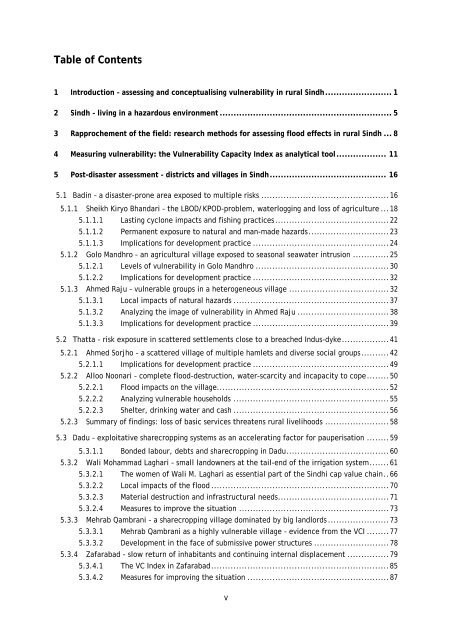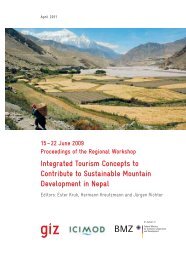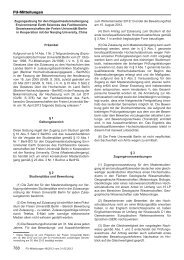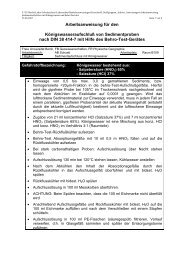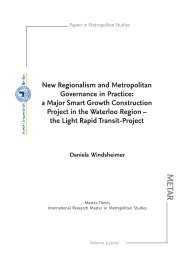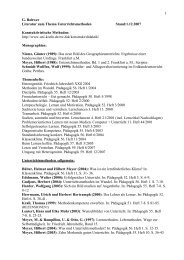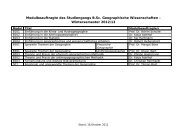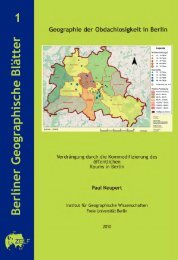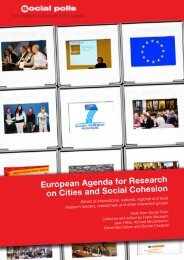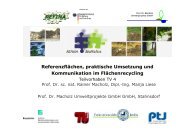After the Flood in Pakistan 38 Berlin Geographical Papers - Freie ...
After the Flood in Pakistan 38 Berlin Geographical Papers - Freie ...
After the Flood in Pakistan 38 Berlin Geographical Papers - Freie ...
You also want an ePaper? Increase the reach of your titles
YUMPU automatically turns print PDFs into web optimized ePapers that Google loves.
Table of Contents<br />
1 Introduction – assess<strong>in</strong>g and conceptualis<strong>in</strong>g vulnerability <strong>in</strong> rural S<strong>in</strong>dh ........................ 1<br />
2 S<strong>in</strong>dh – liv<strong>in</strong>g <strong>in</strong> a hazardous environment .............................................................. 5<br />
3 Rapprochement of <strong>the</strong> field: research methods for assess<strong>in</strong>g flood effects <strong>in</strong> rural S<strong>in</strong>dh ... 8<br />
4 Measur<strong>in</strong>g vulnerability: <strong>the</strong> Vulnerability Capacity Index as analytical tool .................. 11<br />
5 Post-disaster assessment – districts and villages <strong>in</strong> S<strong>in</strong>dh .......................................... 16<br />
5.1 Bad<strong>in</strong> – a disaster-prone area exposed to multiple risks .............................................. 16<br />
5.1.1 Sheikh Kiryo Bhandari – <strong>the</strong> LBOD/KPOD-problem, waterlogg<strong>in</strong>g and loss of agriculture ... 18<br />
5.1.1.1 Last<strong>in</strong>g cyclone impacts and fish<strong>in</strong>g practices ......................................... 22<br />
5.1.1.2 Permanent exposure to natural and man-made hazards ............................. 23<br />
5.1.1.3 Implications for development practice ................................................. 24<br />
5.1.2 Golo Mandhro – an agricultural village exposed to seasonal seawater <strong>in</strong>trusion ............. 25<br />
5.1.2.1 Levels of vulnerability <strong>in</strong> Golo Mandhro ................................................ 30<br />
5.1.2.2 Implications for development practice ................................................. 32<br />
5.1.3 Ahmed Raju – vulnerable groups <strong>in</strong> a heterogeneous village .................................... 32<br />
5.1.3.1 Local impacts of natural hazards ........................................................ 37<br />
5.1.3.2 Analyz<strong>in</strong>g <strong>the</strong> image of vulnerability <strong>in</strong> Ahmed Raju ................................. <strong>38</strong><br />
5.1.3.3 Implications for development practice ................................................. 39<br />
5.2 Thatta – risk exposure <strong>in</strong> scattered settlements close to a breached Indus-dyke ................. 41<br />
5.2.1 Ahmed Sorjho – a scattered village of multiple hamlets and diverse social groups .......... 42<br />
5.2.1.1 Implications for development practice ................................................. 49<br />
5.2.2 Alloo Noonari – complete flood-destruction, water-scarcity and <strong>in</strong>capacity to cope ........ 50<br />
5.2.2.1 <strong>Flood</strong> impacts on <strong>the</strong> village.............................................................. 52<br />
5.2.2.2 Analyz<strong>in</strong>g vulnerable households ........................................................ 55<br />
5.2.2.3 Shelter, dr<strong>in</strong>k<strong>in</strong>g water and cash ........................................................ 56<br />
5.2.3 Summary of f<strong>in</strong>d<strong>in</strong>gs: loss of basic services threatens rural livelihoods ....................... 58<br />
5.3 Dadu – exploitative sharecropp<strong>in</strong>g systems as an accelerat<strong>in</strong>g factor for pauperisation ........ 59<br />
5.3.1.1 Bonded labour, debts and sharecropp<strong>in</strong>g <strong>in</strong> Dadu ..................................... 60<br />
5.3.2 Wali Mohammad Laghari – small landowners at <strong>the</strong> tail-end of <strong>the</strong> irrigation system ....... 61<br />
5.3.2.1 The women of Wali M. Laghari as essential part of <strong>the</strong> S<strong>in</strong>dhi cap value cha<strong>in</strong> .. 66<br />
5.3.2.2 Local impacts of <strong>the</strong> flood ................................................................ 70<br />
5.3.2.3 Material destruction and <strong>in</strong>frastructural needs ........................................ 71<br />
5.3.2.4 Measures to improve <strong>the</strong> situation ...................................................... 73<br />
5.3.3 Mehrab Qambrani – a sharecropp<strong>in</strong>g village dom<strong>in</strong>ated by big landlords ...................... 73<br />
5.3.3.1 Mehrab Qambrani as a highly vulnerable village – evidence from <strong>the</strong> VCI ........ 77<br />
5.3.3.2 Development <strong>in</strong> <strong>the</strong> face of submissive power structures ........................... 78<br />
5.3.4 Zafarabad - slow return of <strong>in</strong>habitants and cont<strong>in</strong>u<strong>in</strong>g <strong>in</strong>ternal displacement ............... 79<br />
5.3.4.1 The VC Index <strong>in</strong> Zafarabad ................................................................ 85<br />
5.3.4.2 Measures for improv<strong>in</strong>g <strong>the</strong> situation ................................................... 87<br />
v


